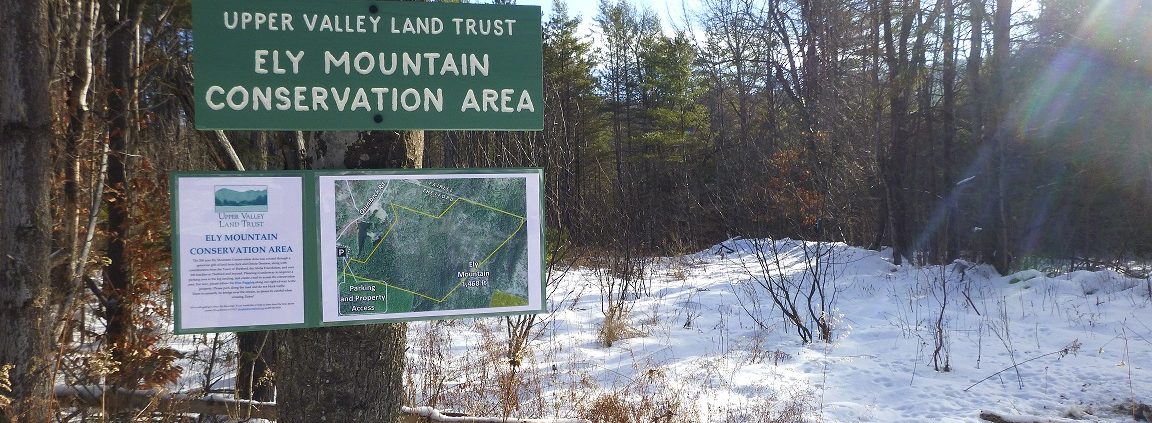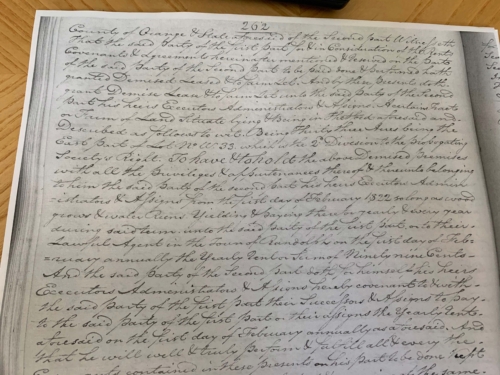Secrets of Ely Mountain
When Land Steward Micah Tilles was an intern at UVLT in the summer of 2020 he was working on getting to know the 187 acre addition that was being added to UVLT owned Ely Mountain Conservation Area in Thetford, VT. While digging through the archives about the property, Micah found that 33 acres of the 187 acre addition had once belonged to The Society for the Propagation of the Gospel in Foreign Parts in the 1700s. The Society for the Propagation of the Gospel in Foreign Parts was created spread of the gospel in the overseas “plaintations, colonies, and factories of Great Britain” through the maintenance of an orthodox clergy and “other provisions necessary” for such aims. Micah took a dive into researching this organization and their ties to Thetford, VT where Ely Mountain Conservation Area is today. Below is his essay.
Propagating Imperialism:
The history of the Anglican Church on a present-day UVLT property
With the stroke of a pen, or perhaps that of a quill, Thetford resident Josiah Ware entered into a lease agreement on March 19, 1824. In exchange for a yearly rent of ninety-nine cents, and so long as wood grew and water ran ([Deed], 1824, p. 262), Ware received the right to use and enjoy a 33-acre half-parcel of land in northern Thetford. The land itself, which lay over 1,500 feet east of Lake Fairlee in what is now a part of a recently-acquired, 187-acre addition to the UVLT-owned Ely Mountain Conservation Area, was not particularly remarkable for its physical characteristics. Long before the parcel had converted to forest, its hilly topography and rocky soils likely promised little more than subsistence cultivation. Instead, the significance of this parcel lies with the identity of its owner. Above Ware’s signature on the original deed was the name of Dudley Chase, a resident of Randolph, and most illuminatingly, the agent and attorney representing The Society for the Propagation of the Gospel in Foreign Parts (SPG), a London-based religious corporation ([Deed], 1824).
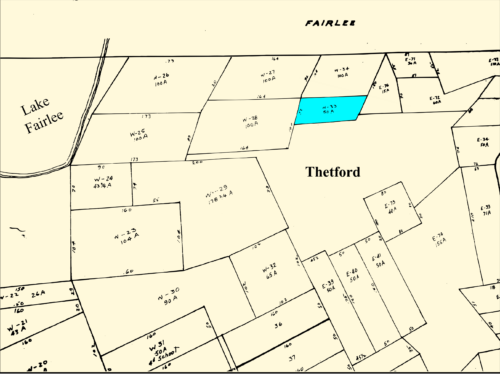
Location of the 33-acre half parcel (highlighted in blue) on the original Thetford parcel map. Map obtained from: Thetford Town Clerk’s Office, 5 Aug. 2020
Uncovered during a visit to the Thetford town archive in 2020, the significance of this peculiar piece of history did not immediately stand out. Yet, within the deed’s slanted script, archaic legal language, and apparent aversion to punctuation, the full name of the Society strikes the eye, both for its length and its unexpected appearance. With a population of 1,915 in 1820 (“Thetford,” 2021), the town seemed too small, too remote for one to reasonably expect a peculiarly-named, foreign organization to have once held land. Spurred on by the appearance of this mysterious Society, additional research has revealed a hidden story behind one of UVLT’s conserved lands and Vermont itself, forcing us to confront an imperialist legacy from the preceding centuries.
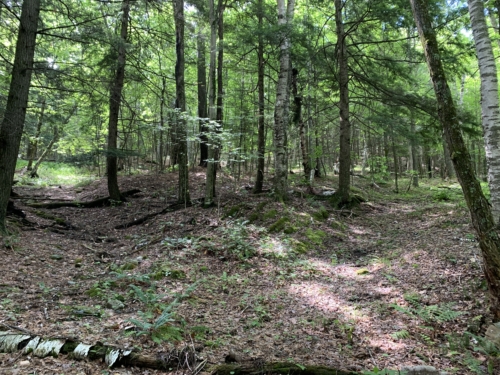
As shown in the above photo, the 187-acre addition to the EMCA is now completely forested. Photo: Micah Tilles, 15 July 2020.
Incorporated in 1701 after receiving a charter from King William III of England (Humphreys, 2009, pp. 13-14), the Society formed under the auspices of The Church of England (Anglican or Episcopalion Church) (McCulloch, 1945, p. 241). With a program to facilitate the diffusion and spread of the gospel in the overseas “plaintations, colonies, and factories of Great Britain” through the maintenance of an orthodox clergy and “other provisions necessary” for such aims (McCulloch, 1945, p. 245), the Society joined the vanguard of what would become an era of growing European imperialism. Edward Said (1979), in his celebrated book, Orientalism, noted that SPG, as an early component of a “complex apparatus” for cultivating British interests in the Near East (p. 100), “openly joined the expansion of Europe” (Tibawi, 1961, as quoted in Said, 1979, p. 100).
As seen by Josiah Ware’s contract with the Society, this imperial expansion was not limited to the East. Emerging with what historian Rowan Strong (2006) described as an “Anglican vision of imperialism” (p. 176), the early leaders of SPG believed that English territorial expansion came with the divine imperative to spread the word of God to foreign lands (p. 184). When casting their eyes across the Atlantic, the Society’s leadership perceived a degenerate colonial population with eroding faith that bordered on apostasy (Strong, 2006, p. 189). Yet, SPG did not limit its work to only the white, colonial settlers. A program of evangelism, directed toward the continent’s indigenous populations and, to a more limited extent, the growing number of African slaves in the colonies, underlined the Society’s imperialist vision (McCulloch, 1945; Strong, 2006). In a meeting in 1710, the Society passed a resolution affirming that the conversion of “heathens and infidels” related directly to the mission of spreading the gospel in the colonies and that such a goal should receive the highest priority (McCulloch, 1945, p. 254). By the turn of the nineteenth century, the Society had missionaries among forty-six Native American tribes (Strong, 2006, pp. 179-180).
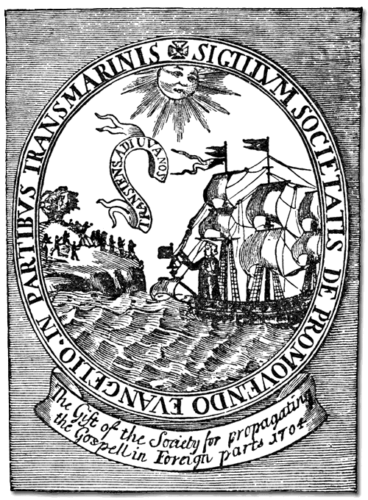
The Seal of SPG in 1704. Notice the contrast between the white, European missionary — the largest figure in the scene — and the darker, indistinguishable “natives,” who, with arms extended, await the salvific “Gift of the Society.” Photo retrieved from: https://en.wikipedia.org/wiki/File:Society_for_Propagating_the_Gospel_seal.gif
Vermont’s, and indeed Thetford’s, role in this broad imperialist discourse remained subtle yet still representative of the Anglican Church’s position in the expanding empire. The Society first acquired land in the then disputed Vermont territory between New York and New Hampshire through a series of land grants given by the Episcopalian Governor of New Hampshire, Benning Wentworth. In an effort to assist his Anglican denomination in a traditionally Puritan region, the governor provided SPG with one share of land in approximately 137 town charters, including Thetford’s, made between 1749 and 1764 (Clarke, 1930, pp. 281-282). These single shares, averaging roughly 250 acres per town, were mostly “situated in the hilly and less desirable parts of the towns” (Clarke, 1930, pp. 282-283). The land comprising much of the Ely Mountain Conservation Area, while today exhibiting high ecological and recreational values, would have, 250 years ago, fit the previous description. The tract’s variegated topography and relative isolation sits in contrast to the flatter and more fertile lands along the Connecticut River. Despite holding land in numerous towns, the Society did not physically engage with any of its Vermont properties (Clarke, 1930). Josiah Ware’s lease agreement with SPG attests to this absentee style of ownership. It can be inferred that the collection of rents, however modest, contributed to the corporation’s conspicuous goal of spreading the gospel — a goal that facilitated, indeed, provided a divine justification for England’s colonial endeavors (Strong, 2006).
Today, the only traces of the Society’s presence in Thetford are found within a handful of property deeds located in the town archive. As part of a process that took over 100 years, the Society had relinquished all of its Vermont lands by 1927 (Clarke, 1930, p. 284). By that year — the same year that Babe Ruth hit a record 60 home runs — the continent that SPG had helped colonize had become unrecognizable from its condition in the eighteenth century. Lands that once belonged to nations, cultures, and traditions that had lasted for centuries had transformed into an American landscape. Even Josiah Ware, if he were to stand there today, would likely not recognize the land he once rented. While our surroundings continuously change, it remains important to reflect on why they changed — to understand why, for example, the town we live in or the hill we hike once had a completely different name 350 years ago. The story of SPG’s involvement in Vermont serves as a reminder to how the history of these lands, including UVLT’s, often tell a not so comforting story about why we are here and not someone else. Words written above such as “evangelism” and “propagation” seem euphemistic considering the violent and dehumanizing legacy of dispossession and ethnic cleansing that accompanied European territorial expansion in the Americas.
References
Clarke, L. D. (1930). Vermont Lands of the Society for the Propagation of the Gospel. The New England Quarterly, 3(2), 279-296.
[Deed]. (1824, March 19). Book 11, pp. 261-263. Town Clerk’s Office, Thetford, VT.
Humphreys, D. (Ed.). (2009). An Historical Account of the Incorporated Society for the Propagation of the Gospel in Foreign Parts. Applewood Books.
McCulloch, S. C. (1945). The foundation and early work of the Society for the Propagation of the Gospel in Foreign Parts. The Huntington Library Quarterly, 241-258.
Said, E. W. (1979). Orientalism. Vintage.
Strong, R. (2006). A vision of an Anglican imperialism: The annual sermons of the Society for the Propagation of the Gospel in Foreign Parts 1701–1714. Journal of Religious History, 30(2), 175-198.
The Seal of the Society for Propagating the Gospel in Foreign Parts [seal]. (1704). Wikipedia. https://en.wikipedia.org/wiki/File:Society_for_Propagating_the_Gospel_seal.gif
Thetford, Vermont. (2021, January 30). In Wikipedia. https://en.wikipedia.org/w/index.php?title=Thetford,_Vermont&oldid=1003686392

